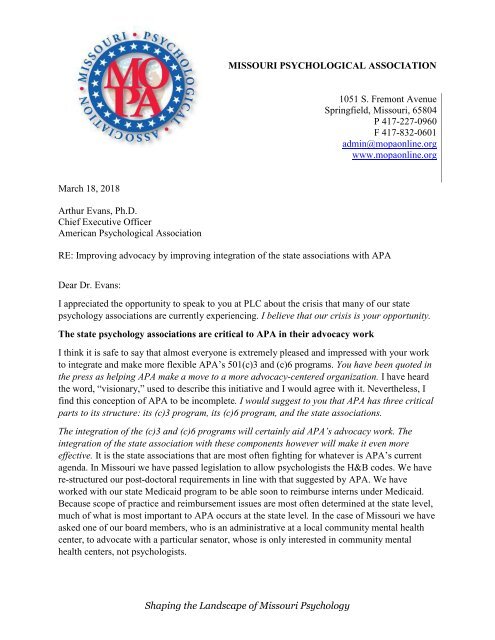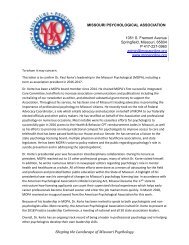MOPA 2018 Letter to Dr. Evans regarding STPAs
Create successful ePaper yourself
Turn your PDF publications into a flip-book with our unique Google optimized e-Paper software.
MISSOURI PSYCHOLOGICAL ASSOCIATION<br />
1051 S. Fremont Avenue<br />
Springfield, Missouri, 65804<br />
P 417-227-0960<br />
F 417-832-0601<br />
admin@mopaonline.org<br />
www.mopaonline.org<br />
March 18, <strong>2018</strong><br />
Arthur <strong>Evans</strong>, Ph.D.<br />
Chief Executive Officer<br />
American Psychological Association<br />
RE: Improving advocacy by improving integration of the state associations with APA<br />
Dear <strong>Dr</strong>. <strong>Evans</strong>:<br />
I appreciated the opportunity <strong>to</strong> speak <strong>to</strong> you at PLC about the crisis that many of our state<br />
psychology associations are currently experiencing. I believe that our crisis is your opportunity.<br />
The state psychology associations are critical <strong>to</strong> APA in their advocacy work<br />
I think it is safe <strong>to</strong> say that almost everyone is extremely pleased and impressed with your work<br />
<strong>to</strong> integrate and make more flexible APA’s 501(c)3 and (c)6 programs. You have been quoted in<br />
the press as helping APA make a move <strong>to</strong> a more advocacy-centered organization. I have heard<br />
the word, “visionary,” used <strong>to</strong> describe this initiative and I would agree with it. Nevertheless, I<br />
find this conception of APA <strong>to</strong> be incomplete. I would suggest <strong>to</strong> you that APA has three critical<br />
parts <strong>to</strong> its structure: its (c)3 program, its (c)6 program, and the state associations.<br />
The integration of the (c)3 and (c)6 programs will certainly aid APA’s advocacy work. The<br />
integration of the state association with these components however will make it even more<br />
effective. It is the state associations that are most often fighting for whatever is APA’s current<br />
agenda. In Missouri we have passed legislation <strong>to</strong> allow psychologists the H&B codes. We have<br />
re-structured our post-doc<strong>to</strong>ral requirements in line with that suggested by APA. We have<br />
worked with our state Medicaid program <strong>to</strong> be able soon <strong>to</strong> reimburse interns under Medicaid.<br />
Because scope of practice and reimbursement issues are most often determined at the state level,<br />
much of what is most important <strong>to</strong> APA occurs at the state level. In the case of Missouri we have<br />
asked one of our board members, who is an administrative at a local community mental health<br />
center, <strong>to</strong> advocate with a particular sena<strong>to</strong>r, whose is only interested in community mental<br />
health centers, not psychologists.<br />
Shaping the Landscape of Missouri Psychology
The state associations are having difficulty maintaining their expertise<br />
Excellence has always been important <strong>to</strong> APA. We want our psychologists <strong>to</strong> be practicing at the<br />
<strong>to</strong>p of their licenses. Organizationally we want APA <strong>to</strong> be a model of excellence. When I testify<br />
at our state legislature, I speak of the need for access <strong>to</strong> expert mental and behavioral healthcare.<br />
And though we all wish the same for our state organizations, we do not always receive the<br />
attention and resources necessary <strong>to</strong> accomplish this, particularly the small and moderate<br />
associations. This is a shame. Because for many people in our individual states, the state<br />
association not APA, is the voice of psychology and what is meant by professional psychology.<br />
State associations are losing their expertise in four ways: 1) State association financial problems<br />
2) ED turnover 3) The replacing of full time EDs with part-time EDs, 4) Rapid board member<br />
turnover, and 5) Lack of support for PLC attendance.<br />
A large majority of our associations that are small <strong>to</strong> medium in size report that they are simply<br />
financially unstable. Last year alone we saw 30% turnover in our states’ executive direc<strong>to</strong>r<br />
positions. Many of our executive direc<strong>to</strong>rs are part-time employees with a limited understanding<br />
of the field of psychology, let alone having an understanding as <strong>to</strong> how APA works. One of the<br />
state association executive direc<strong>to</strong>rs works only one day a week. With each turnover, often<br />
prompted by financial problems, our state associations lose more and more of the expertise<br />
necessary <strong>to</strong> work with APA effectively and <strong>to</strong> promote psychology and APA’s agenda in their<br />
states.<br />
It is flattering <strong>to</strong> hear repeatedly that the state associations “are where the rubber meets the<br />
road.” But there is little discussion as <strong>to</strong> what resources our associations’ need or how they best<br />
might be structured <strong>to</strong> meet this lofty expectation. The tremendous pace of the turnover of state<br />
association executive direc<strong>to</strong>rs undercuts CESPPA’s ability <strong>to</strong> effectively organize any<br />
thoughtful advocacy with APA or <strong>to</strong> be able <strong>to</strong> educate APA on associations’ needs. A majority<br />
of the emails on the CESPPA listserv is about saying hi <strong>to</strong> new EDs, good-by <strong>to</strong> old ones, and<br />
educating the new EDs <strong>regarding</strong> <strong>to</strong> how the system works.<br />
Another contributing fac<strong>to</strong>r is the rapid turnover of association board members. Small<br />
associations do not typically have the committee structure <strong>to</strong> help buffer the additional loss of<br />
expertise that occurs because of this. With increased contributions expected from associations in<br />
order <strong>to</strong> attend PLC, we are now seeing associations send less members <strong>to</strong> the conference, which<br />
impairs the transfer of knowledge about APA. Even one of the larger associations informed that<br />
they were unable <strong>to</strong> afford <strong>to</strong> send their executive direc<strong>to</strong>r this year.<br />
Greater direct financial support would clearly help, but APA could also be helpful in better<br />
promoting membership in the state associations <strong>to</strong> its current members. APA could also<br />
purchase advertising for its products from the state associations or act as sponsors <strong>to</strong> our state<br />
conferences. It would provide speakers <strong>to</strong> our conferences at no cost. It could reduce the costs<br />
and fees <strong>to</strong> participate in PLC.<br />
Difficulty staying connected <strong>to</strong> APA<br />
Relationships are the key <strong>to</strong> any effective business operation. When executive direc<strong>to</strong>rs are new<br />
and have a short tenure, they are constantly trying <strong>to</strong> understand their own state organization, let<br />
alone their more complex connection with APA. This makes it hard <strong>to</strong> use APA as a resource<br />
and <strong>to</strong> be a resource <strong>to</strong> APA.<br />
Shaping the Landscape of Missouri Psychology
Recognition of the state associations within APA needs <strong>to</strong> be ongoing<br />
This is a difficult issue <strong>to</strong> address. I am personally very grateful for the support the CAPP grants<br />
offer our association. I appreciate the guidance and expertise Susie Lazaroff and Dan<br />
Abrahamson and various offices within APA provide. Nevertheless, I believe that we are<br />
somewhat invisible <strong>to</strong> APA as a whole, particularly on a daily basis. We are not part of the<br />
organizational charts. And as we all know, organizational charts are a clear indica<strong>to</strong>r of in and<br />
out groups. They define the relationships and relative rank and authority and power between the<br />
various parts of an organization. If the state associations are truly a critical part of APA, they<br />
should be represented in some fashion on the organizational chart <strong>to</strong> inform those working<br />
within APA of the state association’s importance. This could be done by including CESPPA in<br />
any organizational chart.<br />
There was an interesting absence at PLC this year. There were no shout-outs for the most part<br />
with what various individuals and associations had accomplished that was special this year.<br />
These shout-outs were usually done by <strong>Dr</strong>. Nordal, who had a lesser role in the conference this<br />
year and who rightfully needed time <strong>to</strong> say good-by <strong>to</strong> all of us. I do appreciate the recognition I<br />
personally received from Division 31 this year, but there were likely a lot of association heroes<br />
who were left unrecognized. It is difficult for those who are unrecognized <strong>to</strong> make significant<br />
contributions.<br />
State associations need a clearer and more consistent voice within APA<br />
If our diversity groups have taught us anything, it is the importance of listening for the voice that<br />
has not been heard. If APA is <strong>to</strong> truly represent all psychologists, it should encourage a more<br />
bot<strong>to</strong>m-up agenda and listening style, starting arguably with the needs of its state associations.<br />
We appreciate the recent council move inititated by Peter Oppenheimer, our own Kenneth Baum,<br />
and xxx <strong>to</strong> guarantee each association a spot on the APA council.<br />
NASW introduces new model connecting their national and state organizations<br />
NASW is now funding office costs, staff salaries, and website costs. It is unclear how much<br />
au<strong>to</strong>nomy state offices will have in the future. A portion of all membership funds collected by<br />
NASW can be shared with the state offices, though some state offices find themselves losing<br />
funds.<br />
Summary of suggestions<br />
• Recognize the state associations as structurally a critical part of APA, in the same way we<br />
recognize the (c)3 and (c)6 components.<br />
• Determine what excellence would be at the state level.<br />
• Have a clearer plan <strong>to</strong> help protect the expertise that exists at the state association level<br />
and help the associations become more financially stable. There are numerous direct and<br />
indirect ways that APA could assist the state associations financially and <strong>to</strong> help them<br />
grow membership. Consider sharing APA revenue with the states. Some states may have<br />
<strong>to</strong> develop a (c)3 component <strong>to</strong> help make this work.<br />
• Include CESPPA and the state associations in your organizational charts and involve<br />
them more in APA’s planning and decision-making activities. Collaboration almost<br />
always produces better results.<br />
Shaping the Landscape of Missouri Psychology
• Give the state associations, particularly through CESPPA, a clearer and more consistent<br />
voice and encourage a more bot<strong>to</strong>m-up agenda.<br />
I appreciate your support and hope that those of us working our state associations can take a<br />
more active role in shaping APA’s future success.<br />
Respectfully,<br />
Chuck Hollister, Ph.D.<br />
Chief Executive Officer<br />
Licensed Psychologist<br />
Missouri Psychological Association<br />
Shaping the Landscape of Missouri Psychology



